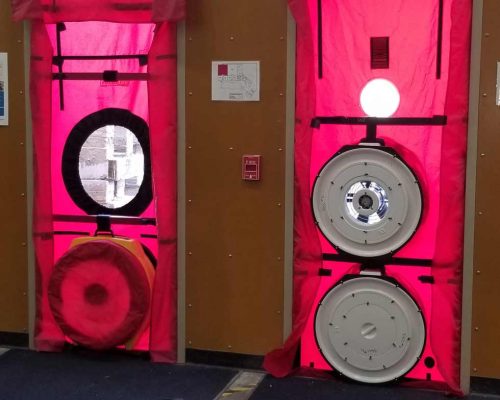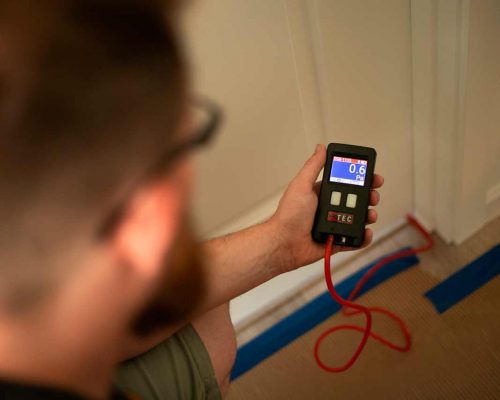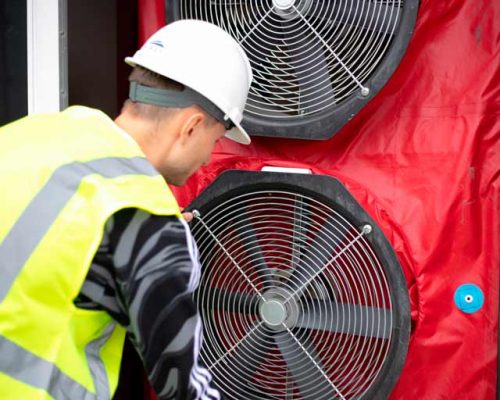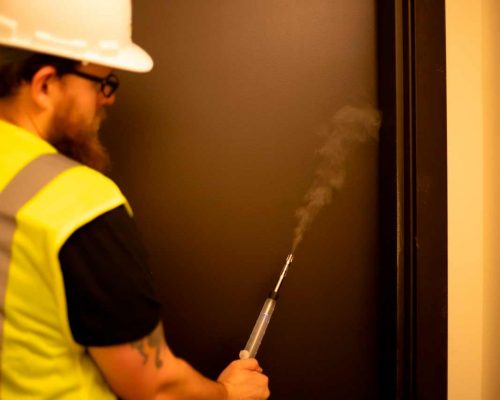Blower Door Testing for Commercial Building Enclosures
Construction standards are quickly evolving. There is a noticeable increase in specifications
being added to building codes. Today’s expectations for a building project are higher than ever
for energy efficiency, indoor air quality, and comfort. That’s why a “blower door test” has become
an important part of every construction project.
Several years ago, the “air barrier check” or “blower door test” was a procedure used only for
small houses, especially with older construction where repairs are needed. Companies now
focus on the air barrier during all phases of every new construction project to ensure the air
tightness of the enclosure from the onset. Energy Incentives has performed whole building air
tightness tests, known as blower door or air barrier tests, on all types and sizes of buildings.
The methods used in performing a blower door test for commercial buildings can make a
difference in the accuracy of the test. When ordering a blower door test there are many factors
to consider. First, you need to know why air sealing is important? How a blower door test
works? Who should test your commercial building? How do I know they’re qualified? What does
success look like?
Our solutions
Why is Air Sealing Important
Buildings constantly undergo influences such as wind, heating and cooling differentials, and
moisture. Yet when a building has proper air sealing and an efficient HVAC system installed,
and it will maintain indoor air moving consistently and comfortably throughout the building.
Gaps in the envelope, places where differing materials intersect, improperly sealed windows or
other openings, even multiple hairline cracks can all interfere with the comfort and energy
efficiency of a building. These unintentional penetrations can result in increased energy cost
and comfort problems. Over time, if not addressed they can even cause mold or mildew.
The 2018 International Conservation Code (IECC) acknowledges the need for either an air
barrier test or visual confirmation of materials. The 2021 IECC requires an air barrier test with
few exceptions. Washington State requires an air barrier test that is even more aggressive than
the IECC requirements.
How Does a Blower Door Test Work
If your building is less than 5,000 square feet in area you may be able to perform a simple single
fan blower door test, much like a single-family residential house. However, for new commercial
buildings larger than 5,000 square feet in area, a blower door test will require several fans, door
set ups, manometers, and specialized software design to sync all the equipment. Protocol for
such tests comes from ASTM E779
An Air Barrier Testing Technician will examine the structure, define the air barrier enclosure,
determine the target air leakage that is allowed, and prepare the test site accordingly. Fans are
installed at exterior doorways. The fans start to pressurize and depressurize the building’s
interior according to the pressure differential selected. After testing multiple points, sensors on
the fans will sync with the software and allow the technician to calculate the building’s air
leakage rate. Commercial grade fans will be able to achieve the proper pressure in no time and
interact with each other in a sufficient manner. They must not interfere with each other and act
together simultaneously. The main goal is that the commercial grade fans work interactively so
they can accurately sense the volume of air changes per unit of time correctly.
Commercial blower door testing gives precise quantities of how much air leaks through the
entire enclosure measured in cubic feet per minute per square foot (cfm/ft 2 ) of the enclosure.
Knowing what the target cfm/ft 2 is depends on which code or standard you are trying to achieve.
Preparing Your Building for an Air Barrier Test
To prepare your building for a blower door or air barrier test standards require that you consider
if you have any “intentional” leaks. Exhaust fans, Heat Recovery Ventilators (HRV), Trash
Exhaust, Fresh Air Intakes are all intentional leaks that are necessary for a healthy building.
The goal of the blower door test is to determine how much “unintentional” air leakage there is.
Steps to prepare the building include:
Seal off the “intentional “leaks (exhaust fans, HRV, fresh air intakes) with tape, plastic
film, or even plywood.
Drains that have traps should have water in them to prevent sewer odors and leaks from
coming into the building.
All interior doors are propped open. To gain access to the exterior walls
All exterior doors and windows are closed and locked. This is to prevent accidental
openings during the test.
All exterior doors should have thresholds and weatherstripping installed.
If a dropped ceiling is in place several panels must be removed
Testing your Air Barrier with blower doors can take from 4 hours to 2 days, depending on the
size of the building. Preparation that requires lifts should be done in advance. Energy
Incentives works with builders to avoid disruption of other trades. Contact us early so we can
accommodate your schedule.
What can a properly installed air barrier do?
Who Should Test my Building
Energy Incentives, INC is a premier building science company. Our background is in high
performance buildings. We have performed blower door tests in buildings that range from 5,000
square feet to 150,000 square feet. We have performed air barrier tests on Grocery Stores,
Office Buildings, Multifamily Buildings, Agriculture Buildings, Warehouses, and Multi-Use
Buildings.
Should a blower door test reveal too much air leakage in your building’s enclosure we will help
identify areas of concern with a thermal scan or smoke test. Our technicians are trained by the
Air Barrier Association of America (ABAA). We have the necessary equipment, training, and
experience to test your building. Located in Washington State, our service area is the greater
Pacific Northwest. However, we have the capacity to travel if needed for your project.
Energy Incentives, INC is certified as a Women Owned Enterprise, a Small Business, and a
HUBZone business. We have over 25 years’ experience in high performance buildings.
vision for the future
Energy Incentives, INC
Energy Incentives, INC is certified as a Women Owned Enterprise, a Small Business, and a HUBZone business. We have over 25 years experience in 3rd party verification of high performance buildings.




